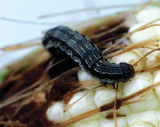
Features
Chemicals
Insects
Battling European corn borer, corn earworm
corn earworm
May 15, 2008 By Dan Woolley
European corn borer and corn
earworm are two of the most economically significant pests for sweet
corn growers says Bernie Solymar of Earth Tramper Consulting.
 |
| Corn earworm is one of the most economically significant pests for sweet corn growers. Ontario crop consultant Bernie Solymar is currently examining a reduced-risk integrated pest management program for the pests. Photo by Jack Dykinga, USDA-ARS |
European corn borer and corn earworm are two of the most economically significant pests for sweet corn growers says Bernie Solymar of Earth Tramper Consulting.
Solymar is currently working on establishing a reduced-risk integrated pest management program for the pests. He has four trials underway in eastern Ontario and Quebec utilizing biological controls to manage them.
Consumers in the fresh produce market “have zero tolerance for insect-damaged corn,” he remarks, adding few growers have their own consultants or crop scouts to do crop monitoring for diseases and pests.
Corn borer overwinters in stalks and cobs, pupating in the spring and feeding on the leaves of the new corn crop. Corn borer adults appear in late May and early June and the later corn borer adults tunnel into sweet corn stalks and cobs.
The corn earworm, however, cannot survive Canada’s cold winters. Instead, it blows north on winds originating in the southern U.S. and feeds on corn silks and ear tips. It is resistant to pyrethroid insecticides, although Solymar says there are other chemical controls that are either very expensive or have a high environmental impact. The corn earworm reproduces through three to four generations in just one growing season in the U.S.
In his research plots, Solymar is examining reduced-risk materials – such as Dipel or Success – as well as bio-controls, including Trichogramma wasps, plus Bt corn varieties, which “very few growers are growing,” he says.
The two wasp species he is working with – T. brassicae and T. ostriniae – are parasites that feed on the eggs of the European corn borer.
While 2007 was a low-pressure year for European corn borer and corn earworm was not a pest management issue, Solymar reports that Dipel performed as well as the conventional controls, either in consecutive applications or alternated with a conventional insecticide, such as Matador.
On 50 per cent of the test sites, T. ostriniae held European corn borer below a damage rate of 2.5 per cent, while T. ostriniae kept corn borer damage at below 25 per cent damage on 100 per cent of the sites.
Solymar estimates that four applications of T. brassicae at 12-day intervals will cost just over $280 per hectare, remarking that just one application of T. ostriniae is worth examining.
According to Solymar, a cost comparison of conventional and alternative controls per hectare includes:
T. brassicae = $71
Lannate = $38 to $60
Dipel = $44 to $48
Sevin = $41 to $46
Furadan = $45
T. ostriniae = $ 38
Other pyrethroids = $25
Matador = $15
For the 2008 growing season, Solymar is continuing to examine the use of Dipel. He is also testing a new reduced-risk product from Dupont that he feels “has a lot of promise” as a corn borer control, as well as continuing his work on earworm controls. His Trichogramma trials will also continue and he hopes to locate more sites for organic trials.
| European corn borer The European corn borer has four stages in its life cycle – adult (moth), egg, larva (caterpillar), and pupa. The winter is spent as a full-grown caterpillar in or near last year’s host plant. While most corn borers probably overwinter in field corn, they can also be found in other host plants such as large-stemmed grasses and various vegetables. Adult – In the spring, the corn borer caterpillar changes to a pupa in Egg – Corn borer eggs are laid in a creamy white mass that resembles Larva – The larvae (caterpillars) that hatch from eggs are about 3 mm Larval colour may vary from pale greyish-brown to dirty white or pale There are four stages in the corn earworm’s life cycle. Earworms arrive Adult – The corn earworm adult is a buff- or tan-coloured moth with a Egg – Although earworms may lay eggs anywhere on the corn plant, almost Larva – Upon hatching, young earworms crawl down the silks toward the Information courtesy of the Ontario Ministry of Agriculture, Food and Rural Affairs |
Print this page